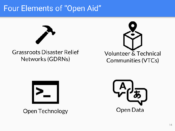I had the honor of presenting “The Rise of Open Aid” at the 2018 NVOAD conference in Providence, Rhode Island, United States. The presentation offered an overview of what is increasingly known as the “open aid movement”: a collection of efforts following the open source way in disaster management and humanitarian aid contexts.
The presentation describes the shared characteristics of “open aid groups” as:
- Often consist of “ordinary people”
- Flexible, mostly horizontal structures
- Form into larger collaborative networks
- Largely volunteer-powered with limited fundraising
- Heavy use of social media for recruitment
- Leverage free and open source software and data
- Can’t operate without open information flows
- Sometimes become nonprofits but often don’t
It goes on to break down the types of open aid groups into four categories, providing a case study from a practitioner in each. The four categories and case study contributors were:
- Grassroots Disaster Relief Networks – Case Study by Jeff Reichman of Sketch City who responded to Hurricane Harvey in Houston Texas.
- Volunteer Technical Communities – Case Studies by Willow Brugh, coordinator of the Digital Humanitarian Network
- Open Source Software – Case Study of Crisis Cleanup by Aaron Titus, founder of Crisis Cleanup.
- Open Data Practices – Case study by Javier Teran of UNOCHA’s Humanitarian Data Exchange Project.
The slides are embedded below and also accessible here.
I’d like to give a big “Thank You” to the folks who contributed to the presentation, to all the open aid practitioners out there that inspired it, and to the broader community of community organizers and disaster professionals working hard to reduce the harm caused by natural disasters and other catastrophic events on people throughout the world.


Leave a Reply